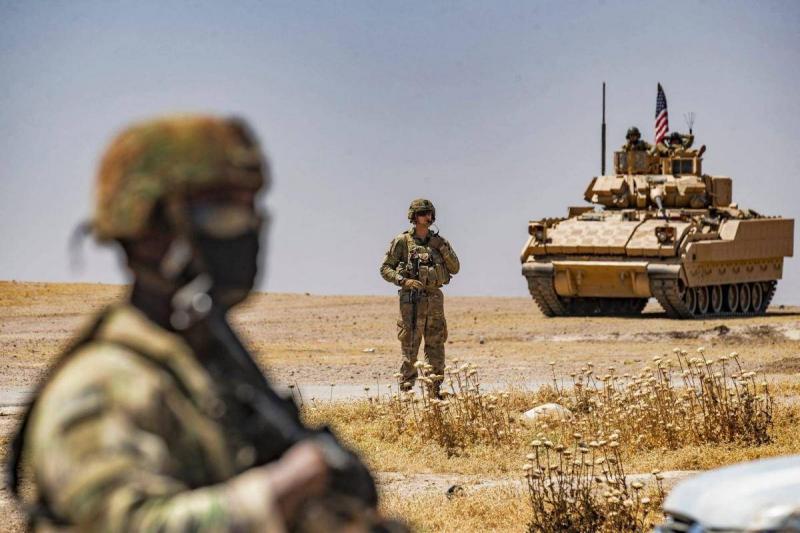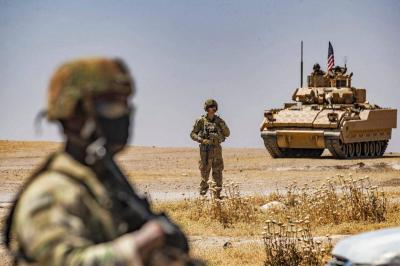U.S. Special Forces are scrambling to contain the resurgence of ISIS, which previously controlled vast territories and millions of people, according to a report by the American newspaper "The Wall Street Journal." ISIS is rallying its forces in the Syrian desert and training young recruits to become suicide bombers, directing attacks on coalition forces, and preparing to revive its dream of ruling an Islamic caliphate, according to U.S. officials and the Syrian Democratic Forces (SDF), which is led by the Kurds and was aided by the U.S. in defeating the extremist organization five years ago.
Militant fighters have ramped up their attacks in Syria and Iraq this year. They have targeted security barriers, detonated car bombs, and planned to free thousands of their imprisoned comrades since the SDF and the U.S.-led coalition regained control of the last town held by ISIS.
In a campaign that has not received much media coverage, U.S. aircraft are conducting airstrikes and providing live aerial surveillance for the ground forces of the SDF, which are conducting raids on suspected ISIS cells. While they usually maintain a safe distance from the fighting, U.S. elite forces sometimes carry out missions alone to kill or capture senior leaders of the organization.
General Rohat Afrin, co-commander of the SDF, told "The Wall Street Journal": "This year has been the worst since we defeated ISIS." In an interview conducted at a U.S. Special Forces base in northeastern Syria, he added, "No matter how many we take down, they will try to rise again."
Elsewhere in the world, ISIS-affiliated groups have carried out terrorist attacks resulting in many casualties, including bombings in Kerman, Iran, and a massacre at a concert in Moscow. However, the organization's focus has been on the region it previously controlled.
The recent resurgence of ISIS presents a different challenge compared to when it was at its peak, with hundreds of militants rushing through isolated villages and crowded cities in tanks and small trucks equipped with machine guns. Now, the organization operates in small cells armed with rifles and explosives.
The response of the U.S., France, and their Western allies is complicated by uncertainty fueled by diplomatic negotiations and upcoming U.S. elections regarding the role the coalition will play in the region in the coming months and years. During the first six months of this year, ISIS declared responsibility for 153 attacks in Syria and Iraq. The organization is building its ranks by covertly indoctrinating youth in camps populated by thousands of the wives and children of detained ISIS fighters.
A U.S. Special Forces officer stationed in Syria stated: "What we are seeing is a movement of men, weapons, and equipment." The SDF, allied with the United States, reported that they arrested 233 fighters suspected of being affiliated with ISIS in 28 operations during the first seven months of the year. U.S. aircraft have conducted three strikes on ISIS targets in Syria and one strike in Iraq this year. The United States, which currently has 900 military and civilian defense personnel in Syria and 2,500 personnel in Iraq, carried out four strikes against ISIS over the past year. U.S. forces have assisted in about 50 other airstrikes carried out by the Iraqi air force since the beginning of last year, according to Pentagon data.
Typically, ground forces of the SDF pursue ISIS cells in villages and towns in northeastern Syria. In a raid in July, the SDF, supported by U.S. Special Forces, targeted eight residential complexes housing militants suspected of being affiliated with ISIS. Planning for the operation took six weeks, during which American drones and Apache helicopters provided aerial surveillance to help the commandos identify patterns of individuals entering and exiting the main buildings. The SDF also built models of the suspected complexes to plan the attack and conducted extensive rehearsals. In the early hours of the raid, over 100 SDF soldiers coordinated their movements to simultaneously reach their designated targets spread across a distance of 10 miles of villages, preventing any ISIS fighters from warning others that they were being encircled.
According to a U.S. Special Forces officer, the SDF managed to arrest dozens of people without firing a shot. Once the residential complexes were secured by Syrian forces, U.S. commandos entered the homes and confiscated mobile phones in hopes of using call logs to locate other ISIS fighters. The U.S. officer stated: "We know this definitely disrupted the planned attacks on coalition and SDF forces."
In Iraq, Shia Muslim leaders have ties to Tehran and are pressing American forces to leave the country, which serves as a logistical base for Pentagon operations in Syria. Last month, U.S.-Iraqi talks in Washington ended without a decision on withdrawal but continue to raise concerns among U.S. allies in the region. Brigadier Ali Hassan, spokesman for the U.S.-allied internal security forces in northeastern Syria, stated: "We will witness chaos like we have never seen before... any withdrawal will lead to an immediate reactivation of sleeper cells."
SDF officers recall that in 2018, then-President Donald Trump ordered the withdrawal of all 2,000 American troops in Syria at that time. Defense officials protested, and Trump was convinced to keep nearly half of them in place. Decisions about whether the U.S. will remain in the fight have become more complicated due to conflicts in Syria.
While the U.S. and the SDF are combating ISIS in the northeastern separatist region of Syria, NATO member Turkey is conducting airstrikes against the SDF, as it considers the Kurds seeking independence to be terrorists. Russian forces are aiding Syrian President Bashar Assad in fighting both the SDF and ISIS. At the same time, militias armed by Iran routinely launch explosive drones at U.S. bases in the region. An attack in January on a U.S. site in Jordan killed three Americans and injured dozens. Earlier this month, an Iran-backed militia launched rockets at the Ain al-Asad airbase in Iraq, injuring five American soldiers and two American contractors, according to U.S. military officials.
For months this year, Iran-backed attacks have forced U.S. forces to bolster their positions in Syria, distracting them from the fight against ISIS. ISIS emerged from a branch of al-Qaeda that fought U.S. forces following the U.S.-led invasion of Iraq in 2003. The U.S. withdrew from Iraq in 2011. ISIS took advantage of this opportunity and seized around 38,000 square miles of territory in Syria and Iraq, an area slightly smaller than the state of Virginia, and declared it a caliphate, ruling over up to 12 million people. Approximately 30,000 foreigners from countries including the UK, France, and Tunisia were drawn to Syria and Iraq to fight on behalf of the caliphate, enticed by the promise of life under strict Islamic teachings.
In 2014, then-President Barack Obama formed an international coalition to assist Iraqi forces and those led by the Kurds in retaking territory in Iraq and Syria. In 2017, Iraqi government forces and Kurdish fighters regained control of the Iraqi city of Mosul after a fierce battle, and the SDF regained control of Raqqa in Syria, which was the capital of ISIS. In 2019, the town of Baghouz, the last stronghold of the organization, fell to the SDF, effectively ending the caliphate.




